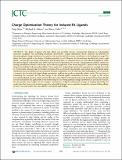Charge Optimization Theory for Induced-Fit Ligands
Author(s)
Shen, Yang; Gilson, Michael K.; Tidor, Bruce
DownloadShen-2012-Charge Optimization Theory for Induced-Fit Ligands.pdf (2.733Mb)
PUBLISHER_POLICY
Publisher Policy
Article is made available in accordance with the publisher's policy and may be subject to US copyright law. Please refer to the publisher's site for terms of use.
Terms of use
Metadata
Show full item recordAbstract
The design of ligands with high affinity and specificity remains a fundamental challenge in understanding molecular recognition and developing therapeutic interventions. Charge optimization theory addresses this problem by determining ligand charge distributions that produce the most favorable electrostatic contribution to the binding free energy. The theory has been applied to the design of binding specificity as well. However, the formulations described only treat a rigid ligand—one that does not change conformation upon binding. Here, we extend the theory to treat induced-fit ligands for which the unbound ligand conformation may differ from the bound conformation. We develop a thermodynamic pathway analysis for binding contributions relevant to the theory, and we illustrate application of the theory using HIV-1 protease with our previously designed and validated subnanomolar inhibitor. Direct application of rigid charge optimization approaches to nonrigid cases leads to very favorable intramolecular electrostatic interactions that are physically unreasonable, and analysis shows the ligand charge distribution massively stabilizes the preconformed (bound) conformation over the unbound. After analyzing this case, we provide a treatment for the induced-fit ligand charge optimization problem that produces physically realistic results. The key factor is introducing the constraint that the free energy of the unbound ligand conformation be lower or equal to that of the preconformed ligand structure, which corresponds to the notion that the unbound structure is the ground unbound state. Results not only demonstrate the applicability of this methodology to discovering optimized charge distributions in an induced-fit model, but also provide some insights into the energetic consequences of ligand conformational change on binding. Specifically, the results show that, from an electrostatic perspective, induced-fit binding is not an adaptation designed to enhance binding affinity; at best, it can only achieve the same affinity as optimized rigid binding.
Date issued
2012-06Department
Massachusetts Institute of Technology. Computer Science and Artificial Intelligence Laboratory; Massachusetts Institute of Technology. Department of Biological Engineering; Massachusetts Institute of Technology. Department of Electrical Engineering and Computer ScienceJournal
Journal of Chemical Theory and Computation
Publisher
American Chemical Society (ACS)
Citation
Shen, Yang, Michael K. Gilson, and Bruce Tidor 2012Charge Optimization Theory for Induced-Fit Ligands. Journal of Chemical Theory and Computation 8(11): 4580–4592. © 2012 American Chemical Society
Version: Final published version
ISSN
1549-9618
1549-9626